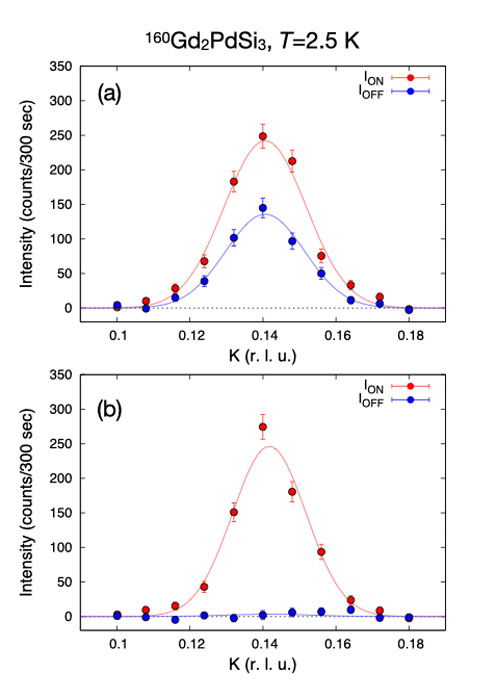Polarized Neutron Scattering Study on a Centrosymmetric Skyrmion Host Gd2PdSi3
Nakajima Group
Gadolinium based intermetallic compounds have been intensively investigated since the discovery of magnetic skyrmion lattice, which is topologically-nontrivial vortex-like spin texture, with the large topological Hall effect in a triangular lattice itinerant magnet Gd2PdSi3 [1]. Although magnetic skyrmions were discovered in chiral ferromagnets such as MnSi [2], the recent study on Gd2PdSi3 has demonstrated that centrosymmetric magnets can also host magnetic skyrmions owing to coupling between local magnetic moments and conduction electrons. Subsequent studies on a breathing kagome system Gd3Ru4Al12 [3] and a tetragonal magnet GdRu2Si2 [4] also reported emergence of skyrmion lattice states. In these studies, resonant X-ray magnetic scattering techniques were used because the L2 absorption edge of Gd is located at 7.935 keV, which is suited for conventional scattering measurements. By analyzing light polarizations of scattered X-rays, magnetic structures in these compounds were investigated. However, resonant X-ray scattering is quite sensitive not only to the magnetic moments but also charge density waves. A recent STM study on GdRu2Si2 reported possible coexistence of magnetic and charge modulations [5]. To verify the magnetic structures in Gd-based skyrmion systems, we employ polarized neutron scattering technique, which can unambiguously distinguish magnetic modulations from charge/nuclear modulations.
In the present study, we focus on Gd2PdSi3, in which the triangular skyrmion lattice state was discovered in the first field-induced phase. In zero field, this system exhibits two magnetic phase transitions, which were identified by previous specific heat measurements, below 21 K. According to the previous resonant X-ray study, the ground state has screw-type magnetic modulations, while the thermally-induced phase was not investigated in detail. We thus studied the temperature evolution of the magnetic order near zero magnetic field by means of polarized neutron scattering.
Gd is one of the strongest neutron absorbers, and thus we used an isotope-enriched 160Gd2PdSi3 crystal, which has relatively weak absorption, for the present study. The experiment was performed at the polarized neutron triple-axis neutron spectrometer PONTA in JRR-3. The sample was mounted in a closed-cycle refrigerator with the (H,K,0) scattering plane. The spectrometer was operated in the Pzz and Pxx longitudinal polarization analysis modes. In the former mode, the direction of the neutron polarization is perpendicular to the horizontal scattering plane. In the latter, neutron polarization is set to be parallel or antiparallel to the scattering vector Q (= ki – kf ).
Figure 1(a) shows a polarized neutron scattering profile of a magnetic Bragg reflection at (0,q,0) measured at 2.5 K. Red and blue symbols correspond to spin-flip (SF) and non-spin-flip (NSF) scattering intensities, which are proportional to Fourier-transformed magnetic moments parallel to the c axis and those perpendicular to both the c axis and q-vector, respectively. Note that NSF signals may also be attributed to a charge or lattice modulation with the same q-vector. We thus measured the same reflection with the Pxx configuration, in which all the magnetic signals are observed only in the SF channel. As shown in Fig. 1(b), we found that the reflection does not contain NSF intensity, demonstrating that the reflection at (0,q,0) is purely magnetic. We thus conclude that the magnetic structure in the ground state is an elliptic screw-type structure. We also measured temperature dependence of the SF and NSF intensities with varying temperature, and found that the c-axis component of the magnetic moments disappears upon the phase transition to the intermediate phase. More detailed analyses are ongoing and will be published elsewhere.
References
- [1] T. Kurumaji et al., Science. 365, 914 (2019).
- [2] S. Muhlbauer et al., Science 323, 915 (2009).
- [3] M. Hirschberger et al., Nat. Commun. 10, 5831 (2019).
- [4] N. D. Khanh et al., Nat. Nanotech. 15, 444 (2020).
- [5] Y. Yasui et al., Nat. Commun. 11, 5925 (2020).

